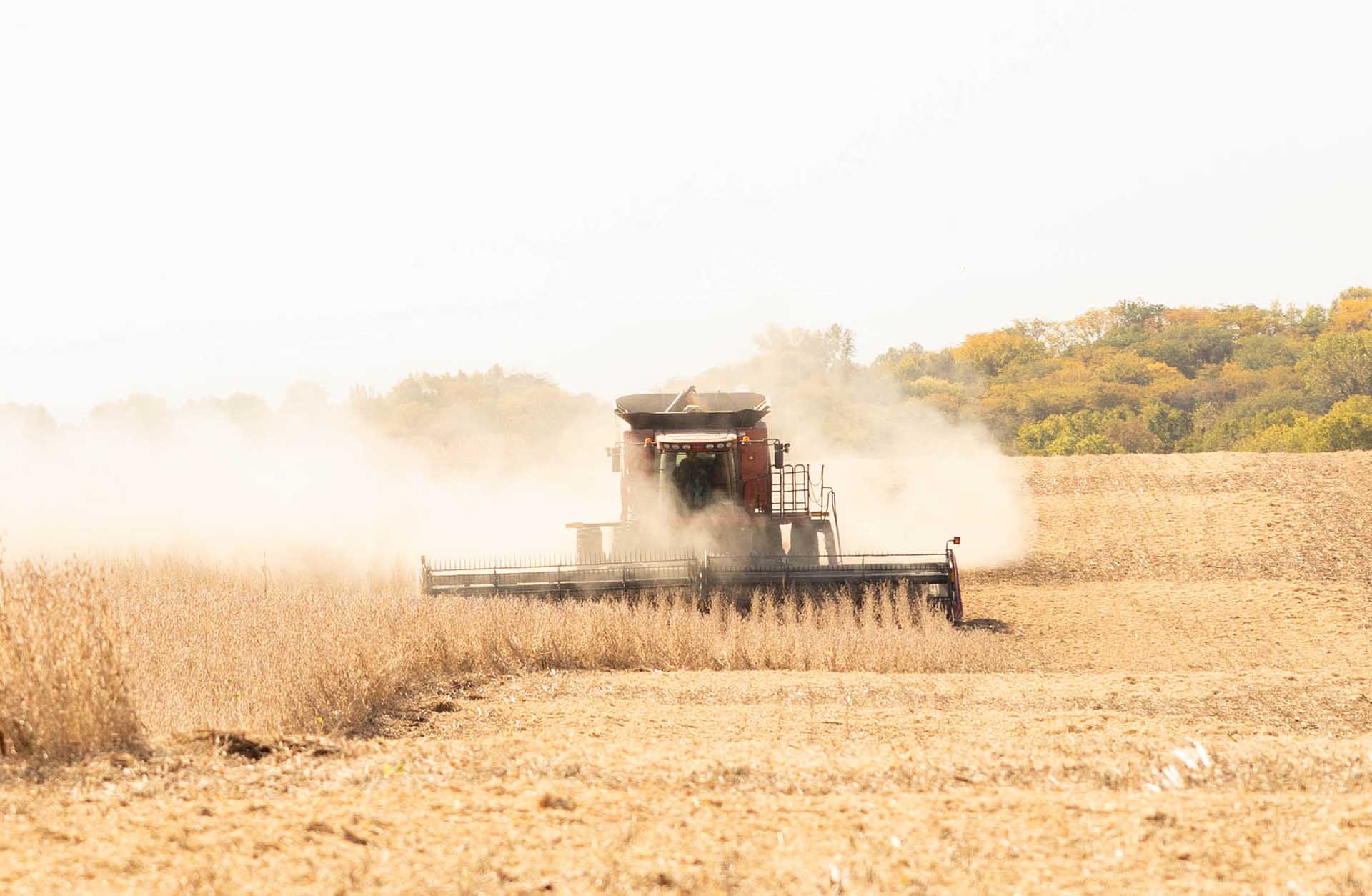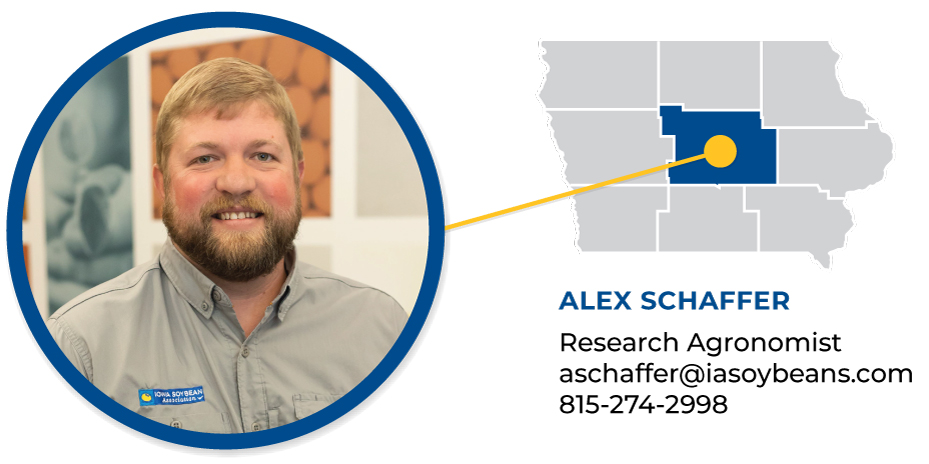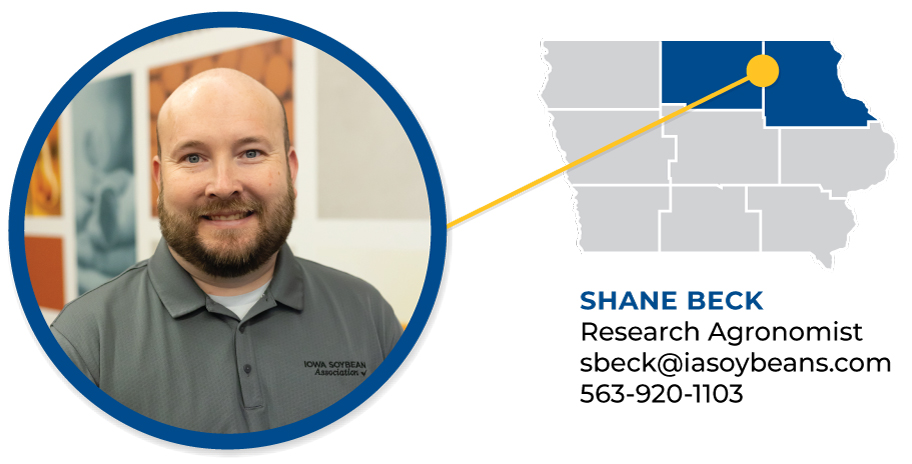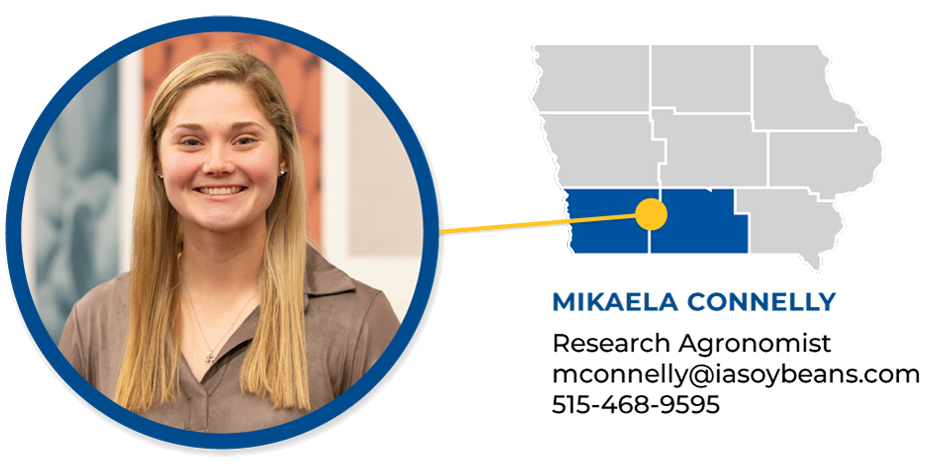
(Photo: Iowa Soybean Association / Joclyn Bushman)
Walking Rows: ISA agronomists update – October 24
October 24, 2024 | Kriss Nelson
According to the Iowa Crop Progress and Condition report, 91% of soybeans and 68% of corn has been harvested. With the completion of the 2024 harvest, farmers are beginning to shift their focus to post-harvest activities.
Iowa Soybean Association (ISA) research agronomists are encouraging farmers to soil test, keeping in mind soil conditions may not favor soil samples until it rains. Additionally, farmers should keep in mind that they must wait for soil temperatures to reach 50 degrees and start to fall before applying anhydrous.
Don't miss out on the chance to participate in fall trials, including the Iowa Nitrogen Initiative and biological study for residue management. Now is also time to prepare fields for any spring trials. If you are interested in participating in trial, reach out to your district’s research agronomist.
Drew Clemmensen – Northwest/Western Iowa
Soybean harvest is all but wrapped up in the northwest and west central parts of the state. Yields ranged from the upper 60s to lower 70 bushels per acre in District 4 and lower 50s to lower 60 bushels per acre in District 1, with a few pockets dipping into the upper 40s.
The corn harvest is wrapping up for most in the west-central part of the state, with yields ranging from 200 to 230 bushels per acre. Moistures have been dry, ranging from 14 to 18%. The northwest portion of the state is a little farther behind, with 2/3 to 3/4 of the corn harvested. Yield ranges in that area vary, ranging from 180 to 250 bushels per acre. Tillage has started in both districts, but most are holding out for some moisture.

A growing season that saw marginal weed control, often justifying late-season herbicide applications combined with an extremely dry fall, might create herbicide carryover issues into the 2025 planting season. Know where these late applications occurred and what products were used to make planting decisions for next year. Work with your advisor to create a game plan now so it is not overlooked when the planting season rolls around next spring. This could include a tillage pass to incorporate the herbicide deeper into the soil profile, diluting the concentration in the seed zone, to potentially not rotating to a susceptible crop and staying with what was planted in the field in 2024.
With the dry soil conditions and warm soil temperatures (which averaged near 60 degrees on Oct. 24), it will be tough, but it is necessary to wait for tillage and NH3 applications.
Although soil sampling is also not advised in these dry conditions, in the spirit of research, I would recommend trying to sample a couple of bags of soil in a few different soil types in a field now. Once we receive some rain, sample again and compare them to samples that were previously dry to better understand the soil sampling process, the need for consistency in sampling year after year and the impact of soil moisture levels on the soil test results.
Lucas DeBruin – Southeast/Eastern Iowa
Harvest continues in my area and manure application is a focus for some.
Fall herbicide applications are also happening. If you have a history of winter annuals or a challenge controlling weeds in the spring, I encourage this to happen. A fall herbicide application can help with spring weed control.
I have seen many drills and air seeders running in fields this week planting cover crops. We got a little rain this week, however, I believe farmers are putting seed out there and hoping it will rain. If it's rye, you will still have good growth potential in the spring.

I've been in a few drone-applied cover crop fields, and it depended largely on moisture for how those fields look; some look great, while others don't have a lot of activity due to the lack of rain.
Will 2025 be a big drought year in Iowa? We will have to see if that rings true.
Margins are tight, and before making any cuts to fertility, please take a soil test to see if and where you can. When pulling a test, remember a few things. Dry soils will show lower potassium levels than damp soils. I would advise allowing rain to fall on the harvested fields before sampling to flush out any nutrients in the fodder and stubble.
Alex Schaffer – Central Iowa
Regarding post-harvest activity, including fall anhydrous, it is important to keep in mind that soil temperatures are not at 50 degrees and falling yet. I advise to consider these three tips to fall anhydrous application.
Patience is virtue for those fields where cover crops have been seeded and have yet to begin growing. I am not concerned about cereal rye, once we get a rain, it should grow, but will this be a different scenario for cover crop blends? Time will tell.

No-till farmers may consider a fall herbicide application with some growing winter-annual weeds. Those weeds to be aware of include henbit, field pennycress and shepherd's purse.
Some farmers might remember seeing henbit last spring. That is the weed that brought a lot of purple flowers in April and May. It could be challenging if you are a no-till farmer trying to plant into a henbit infestation.
You may consider using a growth regulator, such as 2,4-D, and possibly a residual herbicide to help control winter annual weed emergence throughout the rest of the fall season until a hard freeze.
Shane Beck – Northeast/Northern Iowa
As harvest is wrapping up for a lot of farmers in the area, it is a good time to reflect on the growing season. This year was a challenging year early with all the rain and it has been equally challenging lately with the dry conditions.
Some things to think about going into the 2025 growing season include herbicide program, nutrient management, insect and disease management and any overall field concerns.

Are there things that you would like to change prior to next year? Did you have a problem controlling weeds, and are there different herbicides you would like to incorporate into your operation for 2025? What about nutrients? Did you run out of nitrogen for your corn and could benefit from a split application of nitrogen? Did the late aphid population spike cost you some yield? Did the fungicide applications control your diseases or was the timing of the application maybe too early or too late? Are there places in your fields that could use some more tile? Thinking about some of these components can help with purchasing inputs for 2025.
Mikaela Connelly – Southwest/Western Iowa
If farmers are considering a fall herbicide, I advise they should be mindful of any application restrictions, especially plant-back considerations and maximum rates, with the products they're using because this could influence their burndown or post product that will be used next spring. Also, farmers should use different modes of action this fall in case there are resistant weeds in the field and to avoid any weeds building resistance.
Moisture is also a key consideration because some herbicides, specifically residual products, require moisture for activation.

Cover crop seeds that were drilled are emerging slightly better than the seeds that were flown on with a drone. This is mostly likely due to subsoil moisture and potentially better seed-to-soil contact, specifically in high-residue situations.
Regarding harvest, farmers are quickly wrapping up. Most of the fields waiting to be harvested in my area are corn. Most growers are pleased with the yields overall.
From the conversations I've been having in southern Iowa, farmers are waiting until the soil temperatures cool. They also await adequate moisture before rolling any anhydrous tanks this fall.
Unless we receive quite a bit of moisture this fall and winter, I would encourage farmers to err on the side of caution regarding plans for next year's growing season, which could differ from this year. Perhaps farmers changed management items this year, such as hybrid/variety, planting date, or population, from previous years. As harvest wraps up, now is a good time for reflection on how the season went and what, if anything, we could change for next year.
For growers who were enrolled in research trials, their yield files are being collected and sent to the ISA analytics team for processing. I think our future Iowa Soybean Review articles and reports will have a lot of interesting data.
Hope everyone is staying safe as harvest wraps up.
Back